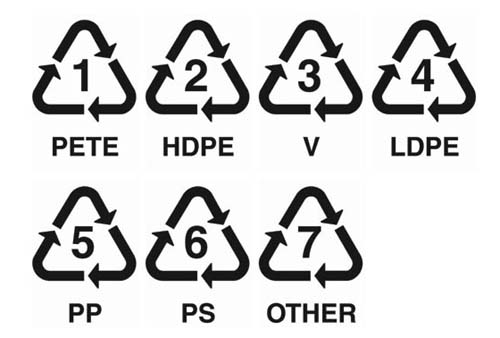|
|
此文章由 viviancn 原创或转贴,不代表本站立场和观点,版权归 oursteps.com.au 和作者 viviancn 所有!转贴必须注明作者、出处和本声明,并保持内容完整
包熟食的塑料袋一般是PVC材质,餐馆外卖的饭盒也是PS材质多,都不好。
能换玻璃就换玻璃吧。
http://life.gaiam.com/article/ar ... ntainers-safe-reuse
Q. Dear EarthTalk: I've read that plastic bottles are not always safe to reuse over and over as harmful chemicals can leach out into the contents. I'm wondering if the same issues plague Tupperware and other similar plastic food storage containers.
— Sylvie, Dawson City, Yukon, Canada
A. The recent hubbub over plastic containers leaching chemicals into food and drinks has cast a pall over all kinds of plastics that come into contact with what we ingest, whether deserved or not. Some conscientious consumers are forsaking all plastics entirely out of health concerns. But while it is true that exposure to certain chemicals found in some plastics has been linked to various human health problems (especially certain types of cancer and reproductive disorders), only a small percentage of plastics contain them.
According to The Green Guide , a website and magazine devoted to greener living and owned by the National Geographic Society, the safest plastics for repeated use in storing food are made from high-density polyethylene (HDPE, or plastic #2), low-density polyethylene (LDPE, or plastic #4) and polypropylene (PP, or plastic #5). Most Tupperware products are made of LDPE or PP, and as such are considered safe for repeated use storing food items and cycling through the dishwasher. Most food storage products from Glad, Hefty, Ziploc and Saran also pass The Green Guide's muster for health safety.
But consumers should be aware of more than just a few “safe” brands, as most companies make several product lines featuring different types of plastics. While the vast majority of Tupperware products are considered safe, for example, some of its food storage containers use polycarbonate (plastic #7), which has been shown to leach the harmful hormone-disrupting chemical Bisphenol A (BPA) into food items after repeated uses. Consumers concerned about such risks might want to avoid the following polycarbonate-based Tupperware products: the Rock ‘N Serve microwave line, the Meals-in-Minutes Microsteamer, the “Elegant” Serving Line, the TupperCare baby bottle, the Pizza Keep' N Heat container, and the Table Collection (the last three are no longer made but might still be kicking around your kitchen).
Beyond BPA, other chemicals can be found in various food storage containers. Containers made out of polyethylene terephthalate (PET or PETE, or plastic #1)—such as most soda bottles — are OK to use once, but can leach carcinogenic, hormone-disrupting phthalates when used over and over again. Also, many deli items come wrapped in plastic made from polyvinyl chloride (PVC, or plastic #3), which can leach cancer-causing dioxins. Swapping foods out of such wraps once the groceries are at home is advisable.
Containers made of polystyrene (PS, or plastic #6, also known as Styrofoam) can also be dangerous, as its base component, styrene, has been associated with skin, eye and respiratory irritation, depression, fatigue, compromised kidney function, and central nervous system damage. Take-out restaurant orders often come in polystyrene containers, which also should be emptied into safer containers once you get them home.
If your head is spinning and you can't bear to examine the bottom of yet another plastic food storage container for its recycling number, go with glass. Pyrex, for instance, does not contain chemicals that can leach into food. Of course, such items can break into glass shards if dropped. But most consumers would gladly trade the risk of chemical contamination for the risk of breakage any day.
Do you know which number plastic bottles are safe to reuse?
April 29, 2009 — yalesustainability

Apparently, according to Trusted MD.com, it is NOT recommended to re-fill plastic bottles made from #1 plastic. And many #7 plastic bottles (bottles made from non 1-6 resins or more than one resin) contains Bisphenol A, a harmful xenoestrogen that interferes with human hormonal messaging. (However, not all – Nalgene makes a non BPA bottle that is made of a #7 plastic)
However, numbers 2 (high density polyethylene), 4 (low density polyethylene), and 5 (polypropylene) should be safe.
One particularly important note to take away from the article is that many baby bottles are made from unsafe materials – as far as chemical toxins go, your best bet for your own water and for babies’ milk and juice is glass or #2 HDPE bottles.
http://yalesustainability.wordpr ... -are-safe-to-reuse/
[ 本帖最后由 viviancn 于 2011-6-13 22:00 编辑 ] |
评分
-
查看全部评分
|
 我的第一条狗狗 (2009-5-27) 知秋一叶
我的第一条狗狗 (2009-5-27) 知秋一叶  彩妆系列征文-单眼皮的痛苦 (2008-11-17) talpey
彩妆系列征文-单眼皮的痛苦 (2008-11-17) talpey  有人清理过ducted heating的管道吗? (2005-3-18) astina
有人清理过ducted heating的管道吗? (2005-3-18) astina  分享在美国的工作和生活,给有意来美的你们(2019旅程结束,回澳了:) (2014-12-18) 谙旎
分享在美国的工作和生活,给有意来美的你们(2019旅程结束,回澳了:) (2014-12-18) 谙旎